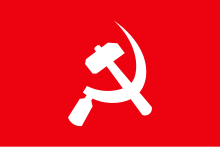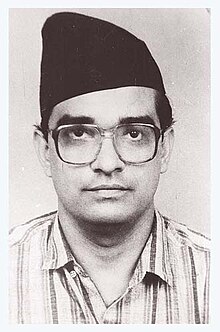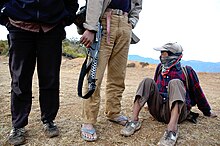
The politics of Nepal functions within the framework of a parliamentary republic with a multi-party system. Executive power is exercised by the Prime Minister and their cabinet, while legislative power is vested in the Parliament.

The Nepali Congress is the oldest democratic socialist political party in Nepal and the largest party in the country. The party has 870,106 members as of the party's 14th general convention in December 2021 making them the largest party by membership in Nepal. Currently the party has started online membership since the emergence of youth leaders in vital post to bring youths into the party.
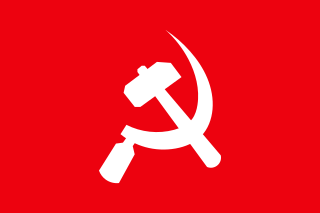
The Communist Party of Nepal, abbreviated CPN, was a communist party in Nepal from 1949 to 1962. It was founded on 15 September 1949 to struggle against the autocratic Rana regime, feudalism, and imperialism. The founding general secretary was Pushpa Lal Shrestha. The founding members of the Communist Party of Nepal were Moti Devi Shrestha, Niranjan Govinda Vaidya, Nar Bahadur Karmacharya and Narayan Bilas Joshi.

The Communist Party of Nepal (Unified Marxist–Leninist) (Nepali: नेपाल कम्युनिष्ट पार्टी (एकीकृत मार्क्सवादी-लेनिनवादी), romanized: nēpāla kamyuniṣṭa pārṭī (ēkīkr̥ta mārksavādī-lēninavādī); abbr. CPN (UML)) is a communist political party in Nepal and the largest party in the current ruling coalition government. The party emerged as one of the major parties in Nepal after the end of the Panchayat era.

The Communist Party of Nepal (Fourth Convention) (Nepali: नेपाल कम्युनिष्ट पार्टी (चौथो महाधिवेशन), Nepala Kamyunishta Parti (Chautho Mahadhiveshan)) was a communist party in Nepal 1974–1990. It was the major communist group in Nepal during the latter part of the 1970s, but gradually lost influence due to internal disputes. The party actively participated in the struggle for democracy in 1990, and its leader took part in writing the Nepalese Constitution. It later merged with other forces to form the Communist Party of Nepal (Unity Centre), out of which the Communist Party of Nepal emerged.

The Communist Party of Nepal, also referred to as the Communist Party of Nepal (Amatya), was a communist party in Nepal. It emerged from a split in the original Communist Party of Nepal (CPN) in 1962. The CPN had been ravaged by internal conflicts due to the Sino-Soviet split and differences of how to relate to political changes in the country.

The Communist Party of Nepal (Marxist–Leninist) was a political party in Nepal. It was launched in 1978 by the All Nepal Communist Revolutionary Coordination Committee (Marxist–Leninist), which was founded by groups involved in the Jhapa movement. The CPN (ML) published Varg-Sangarsh and Mukti Morcha.

Nepal Ratna Man Padavi Madan Kumar Bhandari, commonly known as Madan Bhandari, was a popular Nepali political leader belonging to the Communist Party of Nepal, a democratic communist party in Nepal. He defeated the incumbent Prime Minister Krishna Prasad Bhattarai in a landslide victory in the 1991 general election. Known for his charismatic style, Bhandari propounded the popular communist principle or thought "People's Multiparty Democracy". He is widely regarded for peaking the Nepal's communist movement to a greater height. He died in a jeep accident in Dasdhunga, Chitwan, in 1993.

Mohan Bikram Singh, often referred to as MBS, party name Gharti, is a Nepalese communist politician. His father was a wealthy landlord in Pyuthan District who was close to King Tribhuvan. MBS however joined the opposition Nepali Congress in 1950, and took part in the 1950–1951 uprising for democracy.
Chandra Prakash Mainali more commonly known as C. P. Mainali is a communist politician in Nepal and former Deputy Prime Minister of Nepal.
Pushpa Lal Shrestha was a Nepali politician, considered to be the father of Nepali communism. He was the founding general secretary of the Communist Party of Nepal as well as leader.
Radha Krishna Mainali, better known as R. K. Mainali is a Nepalese politician. In the early 1970s he was one of the radical communists who led the Jhapa rebellion, inspired by the Naxalite movement in India.

The Nepal Communist Party, abbreviated NCP is a defunct communist party which existed in Nepal from 2018 to 2021. It was founded on 17 May 2018, from the unification of two leftist parties, Communist Party of Nepal and Communist Party of Nepal. The unification was completed by the Party Unification Coordination Committee, after eight months of negotiation. The two predecessor parties subsequently dissolved, making way for the new united party. The party retained the electoral symbol of the CPN (UML), the sun.

Sahana Pradhan was a Nepalese politician from a Newar family in Kathmandu. She resigned as Minister of Foreign Affairs of Nepal on April 16, 2008. She also served as Deputy Prime Minister of Nepal within the coalition government of Prime Minister Girija Prasad Koirala from 2007 to 2008.

Keshar Jung Rayamajhi was a Nepalese politician. He was a leading figure in the communist movement in the country, but later turned into a royalist. Rayamajhi hails from a landlord Chhetri family in Tansen, Palpa district.
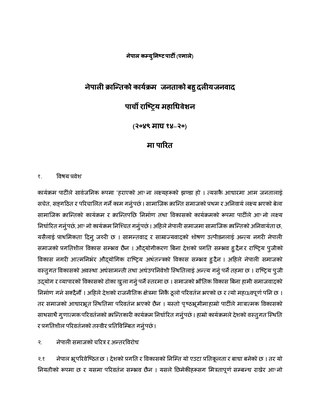
People's Multiparty Democracy refers to the ideological line of the Communist Party of Nepal (CPN-UML), Unified Socialist Party and the former Nepal Communist Party. It was proclaimed in 1993. The idea puts forth a representative democratic multi-party system. It is considered an extension of Marxism–Leninism by Madan Bhandari, the CPN-UML leader who developed it, and is based on the home-ground politics of Nepal.
Lila Nath Shrestha is a Nepali communist politician and a member of the House of Representatives of the federal parliament of Nepal. He was the former Minister of Law, Justice and Parliamentary Affairs and also served as Minister of Women, Children and Senior Citizens. He joined politics as a student and has remained a prominent communist politician from Siraha District.

The First Federal Parliament of Nepal, consisting of the House of Representatives and the National Assembly, was elected via the 2017 legislative, provincial and local elections.

General elections were held in Nepal on 20 November 2022 to elect the 275 members of the House of Representatives. There were two ballots in the election; one to elect 165 members from single-member constituencies via FPTP, and the other to elect the remaining 110 members from a single nation-wide constituency via party-list proportional representation.

At the end of 2020, a major split in the Nepal Communist Party (NCP) revived the Communist Party of Nepal and the Communist Party of Nepal.


